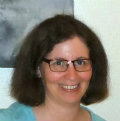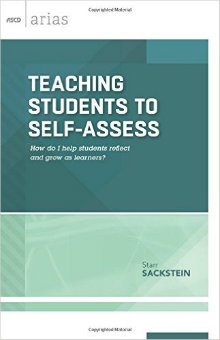Help Students Reflect and Grow as Learners
Teaching Students to Self-Assess: How do I help students reflect and grow as learners?
By Starr Sackstein
(ASCD Arias, 2015 – Learn more)

It’s almost a misnomer to call Teaching Students to Self-Assess a book because it is only 59 pages long and actually only 53 if you count just the actual content pages. However, it is jam-packed with information and is definitely a worthwhile—and quick—read. The subtitle, How do I help students reflect and grow as learners? effectively sums up the focus of the book.

The book includes five chapters, plus an introduction, two appendices (in a section called Encore), a bibliography, a list of related ASCD resources, and a biography of the author. As the book is so short, the chapters do not begin on new pages but merely continue on the same page as the end of the previous chapter, which confused me until I realized what was going on.
A clear, helpful guide to teaching reflection
The chapters progress from defining reflection and providing a rationale for teaching it (Chapter 1), to using reflection in class (Chapter 2), to showing students how to self-assess (Chapter 3), to finding the time to do reflection in class (Chapter 4), and then using the data obtained from student reflections to enhance their learning (Chapter 5).
Subtitles, bulleted lists, and tips are used throughout to highlight important points, and each chapter concludes with three to six questions for the reader to reflect on. Four charts and a few examples of students’ work are also included, which help make the concepts discussed more accessible.
The author offers seven very helpful recommendations on pages 4-6 for how to use reflection effectively in the classroom and how teachers can maximize the benefits of having their students reflect on and self-assess their work.
Teachers who are just starting to have their students do reflections and self-assessments will also find the beginning of Chapter 2, specifically pages 9-13, particularly useful because Sackstein shows how to get students to write actionable goals that they will later use in their reflections. As she writes on page 13, “A goal without an action plan is just an empty statement.” I wish I’d had this information when I was teaching my students!
Formats and questions to engage students
I also liked the author’s idea that students should be allowed to choose the formats for their reflections. She mentions several written, audio, and video options which I am sure will make the idea of doing a self-assessment more palatable to some students.
Sackstein offers a list of 15 questions on pages 18-19 that teachers can use when designing reflection questions for their students. I was glad to find that some of the questions I asked my students to respond to on their self-assessments were included in this list.
Sackstein also suggests that teachers and students utilize Google Forms and Google Docs for completing part of their work, which may not be an option for some teachers. Fortunately, using Google is not essential for having students reflect on their work and do self-assessments. My students managed quite nicely without it but now, after seeing examples of how Sackstein used it, I admit that if I were still teaching, I would probably try it.
Tasks tend to target older students
Although I found Teaching Students to Self-Assess filled with valuable information and I would definitely recommend the book, it became more and more clear as I read it that the book is geared to teachers of older students. Which is not surprising since the author is a high school teacher.
Some of the tasks she suggests teachers do with their students, such as rewriting the standards, having students document all the feedback they receive about their work, and taking only five minutes to write an introduction to their reflections, seem more appropriate for older students who have good organizational and writing skills.
And while Sackstein does include a sample reflection (one of the few in the book; it would have been helpful to have more) from an English Language Learner (thank you!), that student was clearly at a high level of language proficiency. For ELLs at lower proficiency levels, and elementary and many middle school students, these suggestions did not seem practical to me.
This book would be more beneficial if Sackstein had devoted some of her attention to how educators teaching in earlier grades can use reflection and self-assessment with their students.
I thought the conclusion to Teaching Students to Self-Assess was weak. A math example was presented and it seemed like it was there just so something math-related could be included in the book. But the connection between the math concept and teaching students to reflect on their work and assess themselves wasn’t all that clear. It was a disappointing end to an otherwise excellent book.
Susan Schwartz taught EFL/ESL at universities in Asia and a public school in Massachusetts for 25 years and now creates digital education resources. Her seventh and eighth grade students regularly completed written self-evaluations of their work and then created podcasts of them to share with their families. Susan (@The_ESL_Nexus) co-hosts the monthly #ELLEdTech Twitter chat and blogs at The ESL Connection.

































